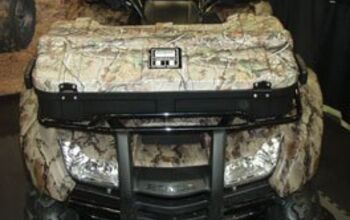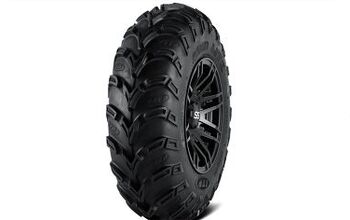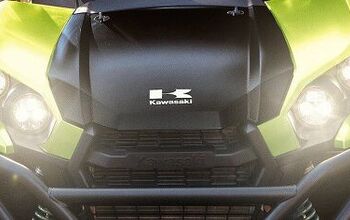Fast And Fun But A Little Bit Weird: Polaris Kinetic XP First Drive

Instant power delivery with almost no noise may seem odd at first, but you get used to it very quickly.
Bits of mud flew into the cabin of the Polaris Kinetic XP UTV as it spun, sticking to my helmet, sunglasses and pretty much everything else in the two-seat interior. I had switched the Kinetic out of 4WD mode and was relying on the rear wheels only for power, and the corner I had joyfully power-slid through 30 minutes ago was a bit more slick than it had been thanks to repeat passes by other drivers.
Despite my best efforts to turn into the slide, the XP executed a graceful (and oddly quiet) 180-degree pirouette on the muddy two-track. I came to an unceremonious stop facing backwards on the side of the trail as the driver behind me piled into the brakes and went wide of the trail and into some tall grass to avoid kissing bumpers.
Oops.
With 140 pound-feet of torque on tap and only two wheels digging into the viscous mud on the rain-slicked test track, the miscue was not entirely unexpected. A bit more gas pedal finesse probably would have saved the skid, but that much torque contained in a short wheelbase and spinning only the two wheels was definitely asking for trouble.
With no harm done except to my ego, I clicked the top of the shifter to “R” for reverse, got mostly straight on the two-track, clicked to F (forward) and pressed the go pedal again, covering the patiently waiting team in the XP behind me with a confetti shower of muddy red clay. Good times! But also interesting, odd, and different times.
Our tour of Polaris' ATV/UTV test route around their massive Huntsville manufacturing complex was putting the Kinetic to a relatively easy test as we traversed open ground, narrow wooded passages and purpose-built crawling and climbing obstacles. Nothing stopped the Kinetic, or even barely slowed it down. And all the while, there was no engine howl, no gear changes, no exhaust fumes of heat filling the air. The capable, controllable and fast-as-you-want (to 60 mph maximum that is) all-electric UTV has arrived with the long-promised Kinetic XP, and it’s now being built in the sprawling factory next to our small off-road adventure track. So how good is it? And how different?
Kinetic Tech
Polaris Kinetic team members who helped develop, design and spec out the new machine made it clear that the new Kinetic XP isn’t Polaris’ first electric UTV. In fact, its the third electric offering from the Minneapolis -based maker of side-by-sides, ATV and snow machines, among other products, including the street-legal Slingshot three-wheeler.
The first Polaris EV UTV was the electric Ranger from about 2010, which was a much more primitive design and a limited production model. It was powered by standard automotive lead-acid batteries and tech more related to golf carts than the off-road Kinetic XP shredder. A second electric UTV that did run on newer lithium-ion tech came and went in the 20-teens. In 2020, Polaris entered into a partnership with established electric motorcycle maker Zero Motors, giving Polaris' electric tech an instant boost, and the new Kinetic XP is the first fruit of that collaboration.
Polaris says the Kinetic chassis is essentially identical to the Ranger 1000 gas-powered UTV, and indeed, Polaris says about 95 percent of the accessories for the Ranger will fit the Kinetic. Where things depart is in the engine and driveline, which consists of a 105-horsepower air cooled electric motor sourced from Zero's top-line electric motorcycles, the SR/S and DSR/X dual sport.
Moving parts are few and Polaris says maintenance for the Kinetic should be 70% less than its gas equivalent, saving owners $3,500 over five years according Polaris’ estimates. The belt drive can be adjusted with a simple tool at a Polaris dealer. Otherwise, there’s no oil to change, gas to fill or gearbox to fiddle with.
Polaris has made some small tweaks to the motor for UTV duty, but it still puts out a crushing 140 pound feet of instant-on torque at all rpms (including 1 rpm). The motor is then coupled via kevlar belt to a simple gearbox with selectable high and low range ratios, but is otherwise a single-speed affair like Zero’s motorcycles. Reverse is activated by a small button atop the gear selector lever that simply reverses the motor’s current.
Moving parts are few and Polaris says maintenance for the Kinetic should be 70% less than its gas equivalent, saving owners $3,500 over five years according Polaris’ estimates. The belt drive can be adjusted with a simple tool at a Polaris dealer. Otherwise, there’s no oil to change, gas to fill or gearbox to fiddle with. A small liquid-cooling system keeps some hot-running electronics in check and the battery packs - buyers can option up for a second unit for 30kWh total - have both heating and forced air cooling systems. Maximum range with two battery packs is about 80 miles, one pack will allow for just over 50 miles according to Polaris.
All that tech is well hidden away down low in the chassis for better handling, with only a J1772 EV plug port and a “horizon” type front line of white LEDs across the front giving away the electric underpinnings - that, and the lack of combustion engine noise. Otherwise, the Kinetic is similar in layout and operation to other Polaris UTVs, with some notable exceptions.
In the cockpit, the Ride Command UI has been tweaked for electric operation, with a new meter on the right showing energy use and regeneration level under braking.
The center touch screen also sports new data points for range, battery level, battery and motor temperature and a duplicate speedometer. 12-volt and USB power ports live below the screen under small caps. When the XP is charging, users can monitor charging status via the Ride Command app - or by peeking at the front horizon light, which cleverly doubles as a charging status meter.
Before our test drive, we got a tour of the Polaris factory where they make the Kinetic and many other UTV models, including the popular Ranger series.
Drive Time
But it’s the driving experience that truly illustrates the difference between the legacy gas and new electric power trains. Torque-rich and almost supernaturally quiet, the Kinetic’s power - in “Standard” mode no less - got me into trouble almost immediately as I dropped the XP out of 4x4 mode to rear wheel drive on a flat and straight section and goosed the accelerator, which sent the back end sliding as the torque instantly overcame the 21-inch off-road tires’ ability to grip the rain-slicked red clay on the Polaris test route.
With no auditory engine cues to rely on, I eased off while turning into the skid and regained control before the Kinetic headed into a chain link boundary fence. I sighed relief at the close call and buttoned the front wheels back into action as we headed into the more wooded and curvy section of the course.
I wasn’t alone in my enthusiasm as several drivers ahead of me were playing with the XP’s ability to grip, with broad rear wheel slides throwing rainbows of mud skyward. You could almost hear the drivers hooting with laughter as the XPs slid around - because, again, no engine roar drowned out their laughter.
Indeed, due to the very quiet drive train, you could hear a lot of unusual things, including vehicle parts hard at work, tree branches scraping as we went down tight passages, ground clearance obstacles crunching underneath, and the occasional clanking or banging as the XP crested steep climbs and bounded through water bars and other challenges. But nothing on the course was a match for the seemingly infinite torque on tap; dialing up instant, deep pools of power was as easy as pressing the foot pedal. I purposely stopped and pinned the front wheels against one obstacle designed to nearly high-center the XP, but a light push on the accelerator and the front tires simply and silently climbed over the mess with zero drama. It was almost too easy. But that ease of use is a large part of the Kinetic XP’s reason to exist.
While it is certainly fun to rip around in, the majority of the XPs sold - and at present they are all sold - will be put to work. And work they can. It’s hard to imagine that the almost smartcar-sized mini machines can haul much, but Polaris said the cargo rating is 1,250 pounds for the small rear bed and the towing is a healthy 2,500 pounds - far more than any of the gas-powered Polaris UTVs. Torque is good.
The Kinetic is not cheap of course. It starts at about $24,000 and can be optioned up to over $33,000 with the additional battery pack and other goodies. And as noted, pretty much all Ranger accessories with bolt right up since the XP’s chassis is based on the Ranger 1000.
And while electric cars constantly fight against “range anxiety” and highway touring ranges that are the inverse of gas-powered autos, the work environment and generally low-speed driving the XP will be called upon to perform actually plays to the strengths of an electric powertrain. Slower speeds mean more miles from the battery, which Polaris says will recharge in 5 hours from a Level 2 charger that they offer from their partnership with charger maker Qmerit.
But the truth of the matter is that most XPs won't see 55 miles of driving in a day, if even half that, so recharge times will be short, and the chargers can be programmed via app to charge when rates are lowest (typically at night). For many users, never having to buy gas for an UTV is almost reason enough to consider the Kinetic; the reduced service costs and simplified drivetrain make it even more compelling. The lack of noise is another bonus, especially for hunters. And when the work is done, stuffing the pedal results in grin-inducing acceleration and hooligan antics, sans noise and exhaust. Welcome to the future.
Polaris says they are looking to ramp up production for an expected surge in new orders when they complete the pre-ordered units.

Motorcycle and mobility journalist, photographer, travel journalist.
More by William Roberson






























![Derek Guetter Crashes During Backflip [video]](https://cdn-fastly.atv.com/media/2022/10/24/8744073/derek-guetter-crashes-during-backflip-video.jpg?size=350x220)














